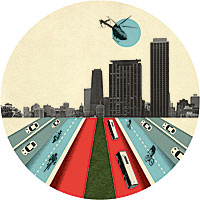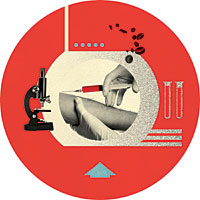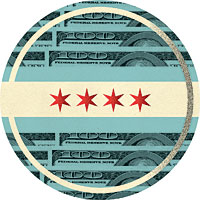Interviews by Marcia Froelke Coburn, David Lepeska, Graham Meyer, and Karen Springen

BIG IDEA 1: Implement creative solutions to Chicago’s traffic headaches.
FOR THE 99 PERCENT: Revamp Lake Shore Drive.
THE RATIONALE: Adding lanes for bus rapid transit, electric vehicles, and bicycles would significantly reduce congestion—and carbon emissions.
THE PROPONENT: Randy Neufeld, director of the SRAM Cycling Fund, a cycling advocacy foundation set up by the Chicago-based bike part manufacturer SRAM, and a board member of the Active Transportation Alliance
HE SAYS: “Forget billion-dollar megaprojects such as monorails. We don’t need to build an expensive new system to unclog the Drive and give everyone a guaranteed quick ride up and down the lakefront.
“Instead the city could create two specialized lanes at minimal cost. One should be for a bus rapid transit system, which is essentially a train system without rails. Rapid transit buses—already operating in places like Bogotá, Colombia—move rapidly. They don’t bog down in traffic like express buses do. And riders pay at stations instead of as they board, which is more efficient. The bus lane would be closest to the median strip. Then there would be a lane for bikes and for light electric vehicles, such as electric assist cargo bikes and solar-charged scooters. Two traditional car lanes would be on the right, where drivers could use the off ramps easily.
“Just imagine: Chicago could be the first city in the world with an express lane—on our signature road!—dedicated to emerging green urban mobility. There are big economic benefits to a Lake Shore Drive that attracts tourists, that serves residents who choose not to drive, and that is 100 percent reliable, regardless of events and weather. And all this could be done within five years.”
FOR THE 1 PERCENT: Bring back helicopter service.
THE RATIONALE: The best way to beat traffic is to fly over it.
THE PROPONENT: Joseph Schwieterman, professor of public service at DePaul University and author of Beyond Burnham: An Illustrated History of Planning for the Chicago Region
HE SAYS: “New York City has an active downtown heliport, but Chicago hasn’t had one since Meigs Field was shuttered in 2003. From 1956 through the mid-1970s, a company called Chicago Helicopter Airways offered frequent flights from Meigs Field to O’Hare (initially just $5 each way) and to Midway. Choppers also once linked Winnetka and Gary, Indiana, to the airports. Service was suspended because of a spike in fuel prices, a recession, and concerns about safety.
“But helicopters today are quieter and safer; the soon-to-be-available Bell/Agusta AW609, a fast-flying tiltrotor using military technology, will be able to fly longer distances too. So let’s put landing pads at the end of Navy Pier, at McCormick Place, at the Illinois Medical District, and near the Museum Campus’s Northerly Island (once the site of Meigs Field). Then anyone willing to pay $100 to $125 each way (less if traveling with three or more other passengers) could bypass the congestion.”
RELATED: Best of Chicago 2012 »

BIG IDEA 2: Diagnose depression with a simple blood test.
THE RATIONALE: Identifying depression earlier means earlier treatment—which can prevent vulnerable people, especially teens, from abusing drugs or taking their own lives.
THE PROPONENT: Eva Redei, a neuroscientist and professor of psychiatry and behavioral sciences at Northwestern University’s Feinberg School of Medicine
SHE SAYS: “Nearly a quarter of people in their late teens suffer from depression. Two-thirds of them are girls. Just as we test people’s blood sugar levels to see if they have diabetes, why can’t we test young people’s blood to see if they are developing depression when they have some recognizable symptoms?
“Teens and their parents would feel the stigma of mental illness less if it can be diagnosed from laboratory tests. And once these adolescents are diagnosed, they could get help before they get into trouble by self-medicating with drugs and alcohol. That makes a big difference with teen girls, whose alcohol use during pregnancy can contribute to fetal alcohol syndrome, which in turn is linked to depression later. It’s a vicious cycle.
“To work toward such a test, starting in 2001 I developed a line of rats that show depressive behavior very similar to that of humans. This research, and another animal model of stress, helped me to identify 11 biomarkers for depression in the blood that seem to identify human depressed teens. It is no surprise, as human and animal brains are remarkably similar.
“So far I don’t know how much the test would cost or exactly when it would be available. Maybe two to six years? A lot depends on funding.”
RELATED: Best of Chicago 2012 »

BIG IDEA 3: Start high school an hour later.
THE RATIONALE: Because lack of sleep is correlated with weight gain, pushing back wake-up times could help fight the teenage obesity epidemic.
THE PROPONENT: Phyllis Zee, professor of neurology and director of Northwestern University’s Sleep Disorders Center
SHE SAYS: “Biologically, teenagers operate in a sort of social jet lag. Their circadian clocks are set to get up later and to go to bed later. Studies show that out-of-sync circadian rhythms are related to obesity, weight gain, and appetite regulation. Yet we force teens into this cookie-cutter school regimen that actually works against them.
“If we started the high-school day one hour later, the results would be tremendous. When people are deprived of sleep, their energy balance is lower, their metabolism slows down, and their glucose tolerance is impaired. Those are risks for diabetes. Also, lack of sleep affects hormones like ghrelin, which tells you when to eat, and leptin, which tells you to stop eating.
“What’s more, in Minnesota and Kentucky, where several counties dialed back the start of the school day, they found that students had better attendance, decreased tardiness, and fewer behavioral problems.”
RELATED: Best of Chicago 2012 »

BIG IDEA 4: Turn blight into bright.
THE RATIONALE: Transforming brownfields into solar-power-generating “brightfields” could provide clean energy and create jobs.
THE PROPONENT: Howard Learner, president of the Environmental Law and Policy Center
HE SAYS: “Chicago has at least 300 brownfield sites—abandoned old industrial areas. They’re a drain on our economy because they are off the tax rolls, not providing jobs, and dragging down neighborhood vitality.
“Sites that aren’t good for redevelopment and are near a transmission grid should be converted to brightfields by installing acres of solar panels that connect to the city’s energy supply. This will create jobs, provide clean energy, and boost tax revenues. We already know how to do it. The largest urban solar project in the country, completed four years ago by a partnership between the city and Exelon, is in West Pullman, on the old International Harvester site. It’s a 10-megawatt project with more than 32,000 solar panels installed by 200 workers that can power close to 1,500 homes.
“Since then, the price of solar panels has dropped like a rock. Solar is now an affordable, smart energy source that can ensure reliability at peak times and diversify the power mix around the city. When the grid is taxed to capacity during summer heat waves, additional solar power will help prevent outages. One thousand acres of brownfields turned into solar brightfields would cost about $750 million, create enough energy for 37,500 homes, and reduce annual CO2 emissions by about 400,000 tons compared with coal.”
RELATED: Best of Chicago 2012 »

BIG IDEA 5: Have the State of Illinois start and run its own bank.
THE RATIONALE: A state bank could help Illinois reduce its budget deficit and make more credit available, thereby boosting the economy.
THE PROPONENT: Tom Tresser, cofounder of Illinois Citizens for Public Banking and a former teacher who coorganized the opposition to the 2016 Olympics
HE SAYS: “Illinois has more red ink than any state but California. It owes $34 billion in principal on its bonds; pension debt stands at $76 billion, the highest in the nation; and it pays a ton in bond interest and fees, not just because it has a poor credit rating but also because it also uses big out-of-state banks and investment firms to do the deals.
“Contrast that with North Dakota. Since the economic downturn began in 2008, North Dakota has had a budget surplus every year. It has no state debt, excellent credit, and the country’s lowest unemployment rate [3 percent]. While student loans in Illinois carry interest of 8 to 12 percent, in North Dakota it’s 4 percent.
“One reason for North Dakota’s prosperity (7.6 percent GDP growth in 2011, the country’s best) is that it has a state bank, the only one in the country. The bank lets the state self-finance: Instead of paying Wall Street to issue its bonds, the state issues its own bonds and invests the savings in schools and other services. Bank deposits are not FDIC insured but rather guaranteed by the state. The Bank of North Dakota has recorded eight consecutive years of record profits, including $70 million last year.
“In the past few years, 18 states have introduced legislation to create a similar bank, including Illinois. It would cost about $100 million to get it going. The bank would partner with local and community banks to make loans to students and businesses, and it could underwrite bonds for municipal infrastructure projects.
“We have never seen a state bank in an economy the size of Illinois, though, so we would have to design this thing carefully. Especially with Illinois’s history of corruption, we’d have to convince the citizens it would be run cleanly.”
RELATED: Best of Chicago 2012 »

BIG IDEA 6: Turn Chicago into the Silicon Valley of education.
THE RATIONALE: Making Chicago a national incubator for educational innovation could fix the city’s broken public schools—quickly.
THE PROPONENT: Timothy Knowles, director of the University of Chicago Urban Education Institute and a clinical professor on the Committee on Education
HE SAYS: “The way to change education here is in a Daniel Burnham way—with big plans. Make Chicago the national locus for education innovation by spending to recruit the highest-performing charter school management organizations and education entrepreneurs to start here and grow here. Draw on both local talent and outside educational innovators. Open the floodgates through private and public investment. Focus on creating uncommon schools that put achievement first.
“In California, the Aspire Public Schools and Rocketship Education charter schools have exceptional schools and the appetite to grow. Critically, they do it at the same per-pupil spending as we get in Chicago. Imagine that on a Chicago-size scale.
“No other U.S. city holds this mantle of education innovation. It would cost a couple hundred million. But Rahm, working together with the local education talent and the business and philanthropic communities, could make this happen in 12 months. And the payback for children would be long lasting.”
RELATED: Best of Chicago 2012 »
Illustrations: Cristiana Couceiro


